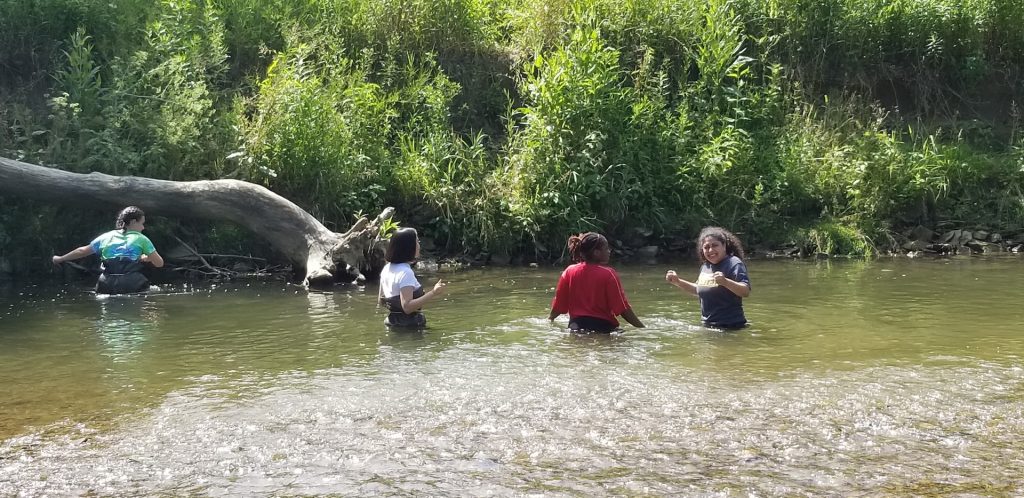Guest bloggers: Chamari Abercrombie and Ellen Yoon.
Good evening Wooster community, today the AMRE Water Team visited Apple Creek with Trout Unlimited to analyze the water quality of Apple Creek. To do so, we looked at macroinvertebrates and collected data from the transducer, which measures water level that we placed in the stream a few weeks ago. Special thanks to Dr. Skip Nault for teaching us about the method and what it indicates about water quality.

 Grace Hodges before she goes in to use the dip net method to collect macroinvertebrates.
Grace Hodges before she goes in to use the dip net method to collect macroinvertebrates.

- Chamari Abercrombie and Layali Banna used the kick seine method to collect macroinvertebrates. Next, Chamari used water to wash the macroinvertebrates into the silver pan while Layali held the kick seine at an angle to prevent the loss of macroinvertebrates.

- Dragonfly larvae and Damselfly larvae were collected during the dip net method.

- Overall data for the collection of macroinvertebrates and water quality – the indicators suggest excellent water quality.
 – The END. We hope you enjoyed our content.
– The END. We hope you enjoyed our content.



Nice work, Chamari and Ellen. Looks like it was a great day to study aquatic macroinvertebrates!
I did this with a group of students in the UP of MI, west of Marquette, and it was a fantastic experience. Almost every kid grows up loving rocks and critters, and somehow, from really poor teaching methods, we scare almost all of them away (but I digress…).
There, a group of concerned citizens was attempting to monitor water quality in a world-famous fishing stream that empties into Lake Superior. From a geological perspective, a Ni-Cu (+ some Au and Pt, to make it worthwhile to mine) sulfide deposit had been opened to underground mining, and the mine was located uphill, and within, the watershed of this stream. So, we see the classic conflict many geologists face, between exploration and development of necessary natural resources, and the protection of the natural world. The unfortunate solution, in most cases, is simply, to take the mining operations to places in the world without any regulations (but I digress…). For those who don’t understand the connection, many metals occur as sulfur-bearing minerals, which, when exposed at the surface to oxidizing surface waters, react to form lots of sulfuric acid (plus toxic heavy metals in solution), producing the appropriately named, “acid mine drainage,” which is extraordinarily harmful to life, in and around the effluent-bearing stream.
Regardless of the socio-economic and political issues that this begins to highlight, the experience of catching, identifying, and monitoring of these invertebrates almost always produces delight in students (and their instructors), and returns them to their love of the natural environment. These types of projects should be standard fare for all students!
BTW, I was at Brown’s Bog the other day, and ran into a group of Oberlin biologists who were trying to understand the habitat as a breeding ground for a particular species of mosquito, one responsible for Eastern Equine Encephalitis. Apparently, Brown’s Bog is the only place in Ohio where this mosquito breeds. Very cool, and strange!
Thank you for sharing!
Thanks for the note Bill – it was our first time through with the survey, but hope to make it a regular part of some classes. We did see the mosquito traps of Oberlin, but were unaware of the study – thanks.